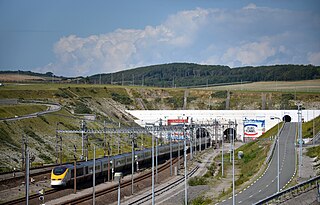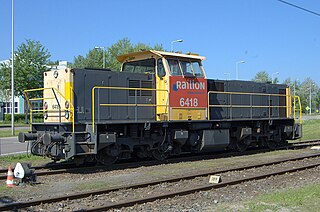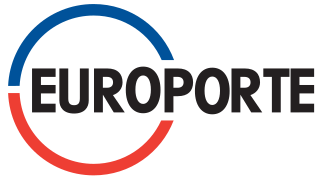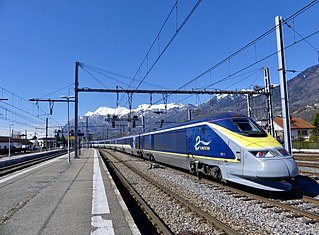
The Channel Tunnel, sometimes referred to informally as the Chunnel, is a 50.46 km (31.35-mile) undersea railway tunnel, opened in 1994, that connects Folkestone with Coquelles beneath the English Channel at the Strait of Dover. It is the only fixed link between the island of Great Britain and the European mainland.

Eurostar is an international high-speed rail service in Western Europe, connecting Belgium, France, Germany, the Netherlands and the United Kingdom.

High Speed 1 (HS1), legally the Channel Tunnel Rail Link (CTRL), is a 109.9-kilometre (68.3-mile) high-speed railway linking London with the Channel Tunnel.
Getlink, formerly Groupe Eurotunnel, is a European public company based in Paris that manages and operates the infrastructure of the Channel Tunnel between France and the United Kingdom, operates the LeShuttle railway service, and earns revenue on other trains that operate through the tunnel.

Railfreight Distribution was a sub-sector of British Rail, created by the division in 1987 of British Rail's previous Railfreight sector. It was responsible for non-trainload freight operations, as well as Freightliner and Intermodal services. In its early years, the division was occasionally referred to as Speedlink Distribution. It was later responsible for freight operations through the Channel Tunnel.

The British Rail Class 92 is a dual-voltage electric locomotive, which can run on 25 kV AC from overhead wires or 750 V DC from a third rail. It was designed specifically to operate services through the Channel Tunnel between Great Britain and France. Eurotunnel indicates the Class 92 locomotive as the reference for other locomotives which railway undertakings might want to get certified for usage in the Channel tunnel.

The Eurotunnel Class 0001 Bo-Bo diesel-electric locomotives were built by Maschinenbau Kiel between 1991 and 1992. They are very similar to the NS Class 6400. When operating in the United Kingdom, the locomotives are assigned a TOPS classification as Class 21.

The NS Class 6400 is a type of Bo-Bo diesel-electric freight locomotive. 120 were built by MaK and ABB between 1988 and 1994 for Nederlandse Spoorwegen.

DB Cargo France is a French rail freight operator. It is presently a subsidiary of the German state-owned logistics company DB Cargo.
The Nightstar was a proposed overnight sleeper train service from various parts of the United Kingdom to destinations in mainland Europe, via the Channel Tunnel, in the mid 1990s. To run alongside the Eurostar, and north of London day-time Regional Eurostar services which were never operational, the Nightstar was the last part in a proposed round-the-clock passenger train utilisation of the Channel Tunnel.

GB Railfreight (GBRf) is a rail freight company in the United Kingdom. As of 2022, it is owned by the global investment company Infracapital, itself a subsidiary of M&G plc, a UK investment group.

Europorte is a European rail freight company, a subsidiary of Getlink; operating in France and through the Channel Tunnel.
Veolia Transport Nederland was one of the two Transdev operations in the Netherlands operating bus, train and ferry services. It was a subsidiary of Transdev Netherlands. It ceased in December 2016 with the remaining operations rebranded as Connexxion, also another subsidiary of Transdev Netherlands.

RAIL4CHEM was a German rail freight transport company, and the parent company of a number of European subsidiary rail freight transport companies including rail4chem Benelux B.V. (Rotterdam), the rail4chem transalpin AG (Basel) and Fer Polska S.A. (Warsaw).
Chemins de fer et transport automobile (CFTA) was a French transport company descended from the Société générale des chemins de fer économiques which operated thousands of kilometres of local railways in France in the late 19th century through to the 1930s.

Veolia Cargo was a European rail freight transportation company that operated mainly in France and Germany. On 2 September 2009, the company was acquired by Eurotunnel and SNCF, the deal being finalised on 1 December 2009.
SNCF Logistics was the division of the SNCF group responsible for freight transportation and logistics.

The British Rail Class 373, known in France as the TGV TMST and branded by Eurostar as the Eurostar e300, is a French designed and Anglo-French built electric multiple unit train that was used for Eurostar international high-speed rail services from the United Kingdom to France and Belgium through the Channel Tunnel. Part of the TGV family, it was built with a smaller cross-section to fit the smaller loading gauge in Britain, was originally capable of operating on the UK third rail network, and has extensive fireproofing in case of fire in the tunnel. It is both the second longest—387 metres —and second fastest train in regular UK passenger service, operating at speeds of up to 300 kilometres per hour (186 mph).

MS Al Andalus Express is a freight ferry owned by Eurotunnel and operated by Naviera Armas. She was built in 1987 by Chantiers du Nord et de la Mediterranee, Dunkirk for Societe Nationale des Chemin de Fer Francais (SNCF) as a multi-purpose passenger and roll-on roll-off ferry for lorries and railway vehicles. After the introduction of Eurotunnel there was no need for a train ferry, so SNCF was losing money running her. She was acquired by SNAT and Stena Sealink in 1989, which operated the Nord Pas-de-Calais until 31 December 1995. From 1 January 1996 SNAT operated as SeaFrance. The vessel was renamed SeaFrance Nord Pas-de-Calais. SeaFrance operated until November 2011, and was liquidated on 9 January 2012. Eurotunnel won the bid for the three of the former SeaFrance vessels the original name of the vessel was restored, dropping the SeaFrance prefix. MyFerryLink started running on 20 August 2012, although Nord Pas-de-Calais joined in November 2012 following a refit. Following MyFerryLink's cessation of operations, mostly cited due to financial issues, the ferry was used directly by Eurotunnel to carry hazmat cargoes that are not allowed on regular train services.

The second use of the TOPS classification Class 21 for locomotives used on the British railway network came through the use of a number of related diesel-hydraulic and diesel-electric locomotives procured following the opening of the Channel Tunnel. The total of 16 locomotives were obtained by two separate operators, with some used for freight, and others to propel service trains and as "Thunderbird" locomotives.














